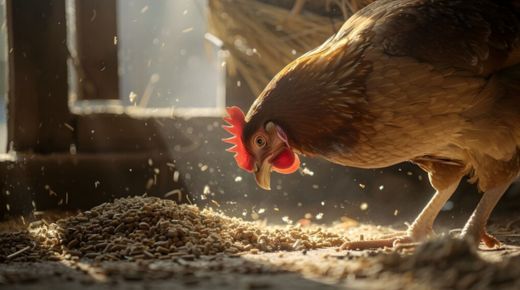Raising healthy and productive poultry requires more than just proper feed and water. One often overlooked but essential component in a bird’s diet is poultry grit. Poultry grit plays a critical role in aiding digestion and ensuring your flock maintains optimal health. In this guide, we’ll delve into what poultry grit is, why it’s important, and how to incorporate it effectively into your flock’s routine.
What is Poultry Grit?
Poultry grit consists of small, hard particles like crushed granite or flint that birds ingest to aid their digestion. Unlike mammals, poultry lack teeth and rely on their gizzards to break down food. The gizzard, a muscular part of the digestive tract, uses poultry grit to grind up food into smaller, digestible pieces. This process is vital for birds to efficiently process nutrients from their diet, particularly when consuming coarse feeds or whole grains.
There are two main types of poultry grit:
- Insoluble Grit: This is the most common type of grit, typically made from granite or crushed stone. It remains in the gizzard for extended periods and aids in grinding food.
- Soluble Grit: Usually made from crushed oyster shells or limestone, this type of grit dissolves in the bird’s system and provides a source of calcium, which is especially beneficial for laying hens.
Both types serve essential roles in poultry health, ensuring proper digestion and nutrient absorption, with soluble grit also contributing to the formation of strong eggshells.
The Role of Poultry Grit in Digestion
For poultry, the process of digestion begins when food enters the crop, a pouch in the esophagus where food is stored and softened. From there, the food moves into the gizzard. Without poultry grit, the gizzard cannot effectively break down food, leading to indigestion, poor nutrient absorption, and even blockages.
Birds that eat coarse grains, seeds, or forage need insoluble poultry grit to grind down these tougher materials. Without it, they may experience digestive issues such as crop impaction or nutrient deficiencies. Grit serves as a natural grinding tool that keeps the digestive system functioning smoothly, promoting overall health and productivity.
Benefits of Poultry Grit
Incorporating poultry grit into your flock’s diet provides several key benefits:
- Enhanced Digestion: Poultry grit enables the proper grinding of food in the gizzard, ensuring that the nutrients in the feed are more accessible for absorption. This is crucial for birds eating unprocessed grains, seeds, or foraging on grass and insects.
- Increased Nutrient Absorption: By breaking down food into smaller, more digestible pieces, poultry grit helps your flock get the most out of their feed. This leads to better growth rates, improved feather quality, and enhanced overall health.
- Prevention of Digestive Disorders: Without access to grit, birds can suffer from digestive issues such as crop impaction and gizzard dysfunction, which can be painful and even fatal. Grit helps prevent these conditions by facilitating proper food breakdown.
- Support for Egg-Laying Hens: Soluble grit, like crushed oyster shells, provides the calcium needed to produce strong eggshells. A deficiency in calcium can lead to thin-shelled or malformed eggs, which is detrimental to both the hen’s health and egg production.
How to Provide Poultry Grit to Your Flock
Poultry grit should be available to your birds at all times, especially if they are free-ranging or consuming coarse feeds. While some commercial poultry feeds come pre-ground, free-range birds or those eating whole grains will still need supplemental grit to aid in digestion.
Tips for Providing Grit
- Free-Choice Grit: Offer grit in a separate container so birds can consume it as needed. They will instinctively regulate their intake based on their dietary needs.
- Choose the Right Size: Make sure the grit you offer is appropriately sized for your flock. Chicks need smaller, finer grit, while adult birds can handle coarser particles.
- Supplement with Soluble Grit for Layers: If you have laying hens, provide them with a source of calcium-rich soluble grit, like oyster shells, to support eggshell production. This can be offered separately or mixed into their feed.
- Monitor Consumption: While most birds will instinctively consume the correct amount of grit, it’s essential to monitor their behavior. If you notice signs of digestive distress, such as a lack of appetite or lethargy, check to ensure they are getting enough grit.
Common Misconceptions About Poultry Grit
Despite its importance, there are several misconceptions surrounding the use of poultry grit:
- Grit is unnecessary if you feed commercial poultry feed: While most commercial feeds are pre-ground, grit is still beneficial for birds that have access to the outdoors or eat coarse grains. Grit remains essential for birds on mixed or free-range diets.
- Chicks don’t need grit: Chicks consuming only starter feed may not require grit, but if they are exposed to grains or other solid foods, grit should be introduced to aid digestion.
- All grit is the same: Insoluble and soluble grit serve different functions, and each should be provided according to the flock’s needs. Laying hens, in particular, require additional calcium for egg production, so offering both types is beneficial.
Conclusion
Poultry grit is a simple yet vital component in maintaining the health of your flock. By aiding in digestion, improving nutrient absorption, and preventing digestive disorders, poultry grit ensures that your birds remain healthy and productive. Whether you have backyard layers or free-range foragers, providing access to high-quality grit is essential for their well-being. Always ensure that the type and size of the grit you offer is appropriate for the age and dietary habits of your flock, and you’ll enjoy the benefits of healthier, more robust poultry.




